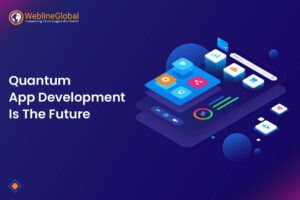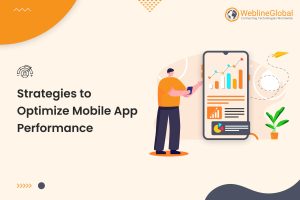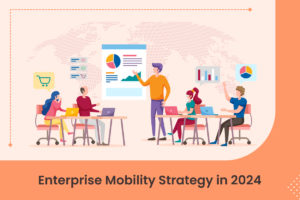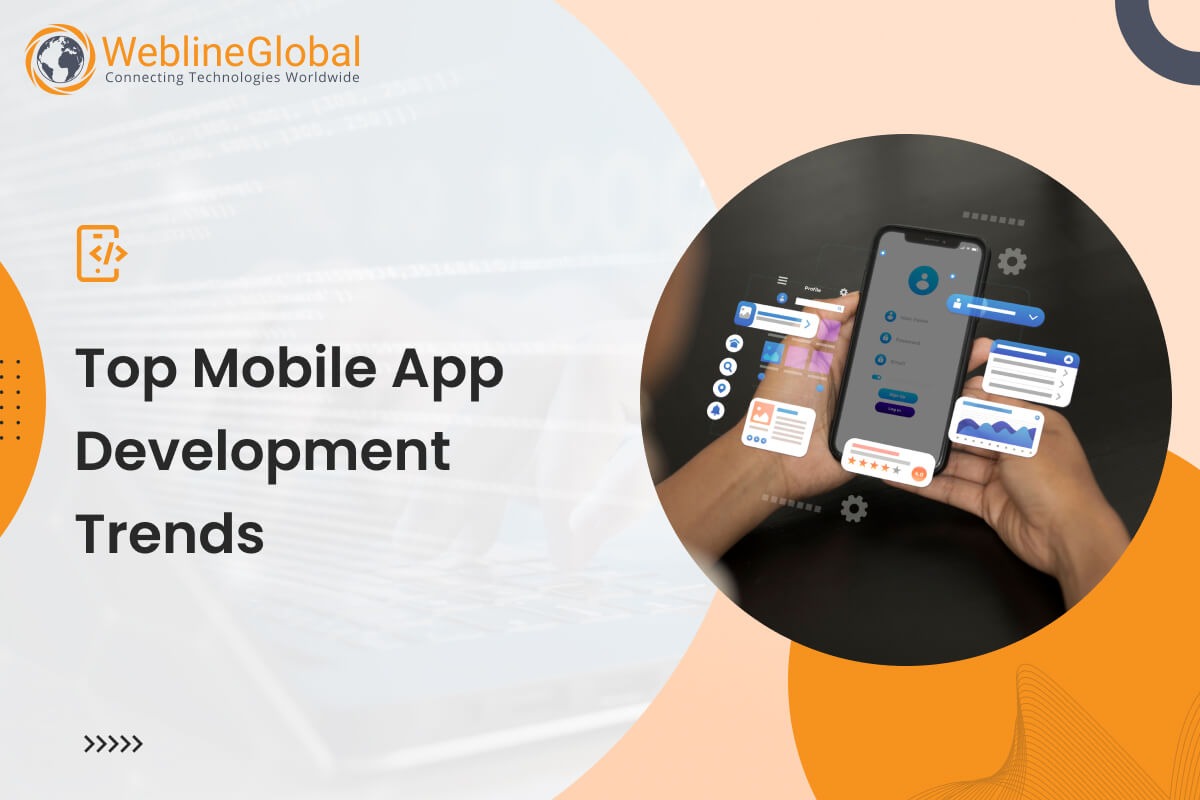
We live in a mobile-first world. The apps on our smartphones are some of our most frequently used programs, tools, and sources of entertainment. In 2022 alone, consumers downloaded close to 142 billion mobile apps, a number that’s projected to climb above 200 billion by 2025.
With mobile apps quickly becoming ubiquitous and indispensable in our daily lives, where exactly is the development of the latter headed in the future? What new mobile trends in 2024 will define the way we develop and engage with apps on our devices in the future is a concern.
In this guide, we will explore some of the major mobile app development trends experts anticipate they will come up and develop by 2024. Following trend developments, different businesses can develop better mobile apps that meet users’ needs.
The Future of Mobile Apps: Development Trends to Expect in 2024 & Beyond
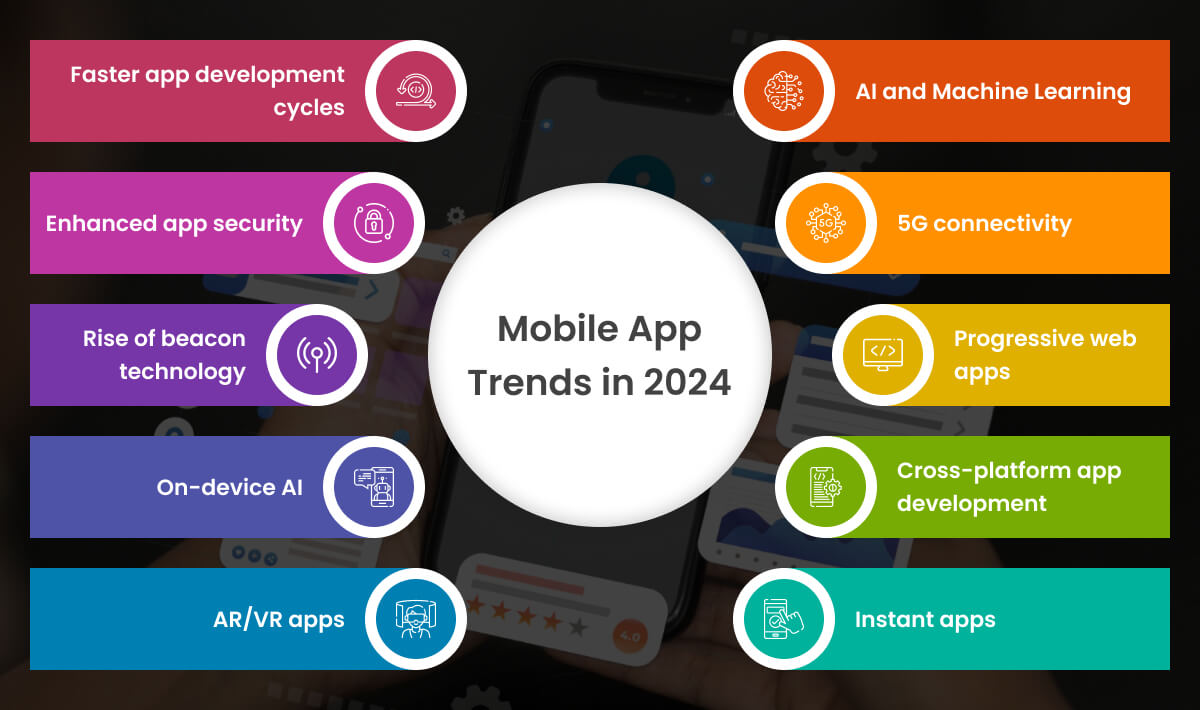
- AI and Machine Learning
- 5G Connectivity
- Progressive Web Apps
- Cross-Platform App Development
- Instant Apps
- AR VR Apps
- On-Device AI
- Faster App Development Cycles
- Enhanced App Security
- Rise of Beacon Technology
AI and Machine Learning
The latest technologies such as Artificial Intelligence or AI mobile app development blended with Machine Learning have made significant forays into building software solutions. And with further advancements, we see these technologies igniting more refined and personalized app interfaces. There will be contextual recommendations as the app learns user behavior and engagements. Likewise, the AI chatbots will learn to be smarter to deliver a human-like conversation experience. The advantage to the developers is that they can build an application with inherent app performance optimization, ensuring it achieves peak performance over time without necessarily requiring frequent updates.
5G Connectivity
5G networks have started being deployed, and by 2024, we may find it widespread. It provides high-speed Internet services, reduced latency, and increased connectivity, unlike 4G. This presents an exciting prospect for mobile app development in 2024 – whether it is the development of multiplayer ARVR apps, effortless video streaming, or connected vehicle technology. Super-responsive networks enable apps to take advantage of cloud power with features that were never possible in the past.
Progressive Web Apps
In the future, progressive web apps PWAs will be a high-priority option for many app developers. PWAs are web apps that use standard web programming languages such as HTML, CSS, and JavaScript but are designed to work like native mobile applications.
Some key advantages of PWAs include:
- Work across platforms – create the app using one code across iOS and Android.
- It is built faster than native apps and can provide rapid updates based on customer feedback.
- Works offline and uses less data since some content is stored on the device cache.
- This is because they are indexed like web pages for easier discovery through search engines.
- Lower development cost relative to native apps
Due to such benefits, more developers will decide on PWAs for apps that don’t need full access to native devices. Enterprise apps, e-commerce touch points, LOBs, and newer startups with budget app development will become more prominent in using PWAs.
Cross-Platform App Development
Customized app development is challenging due to the rising diversity of smartphones and operating systems. Developing native apps for every platform costs a great deal in terms of money and time. Enter the stage of cross-platform app frameworks such as React Native and Flutter. They help code developers write for iOS and Android platforms and even desktop apps. Cross-platform app development will remain popular, ensuring developers design good apps quickly and on budget.
Instant Apps
2016 was when Google invented instant apps, and this idea will become more widespread in years to come. Instant apps give users the feeling of a native app without installing anything. Users can start instant apps right away with a URL on Android devices. This would enable app developers to set up an advanced application version that can provide key features and functionalities before persuading users to install the complete package.
Also, read the blog on Step-By-Step Method To Build An On-Demand Delivery App
AR/VR Apps
The launch of Apple’s ARKit and Google’s ARCore finally made mobile-based augmented and virtual reality more popular. These platforms enable developers to incorporate augmented reality into their iOS and Android apps.
Shopping apps, games, and social media are areas where we can see AR experiences becoming more common as time goes on. VR headsets are also getting cheaper and less heavy. All this indicates that AR and VR will continue to be used more innovatively in mobile apps years from now.
On-Device AI
AI capabilities integrated into smartphones will enable developers to build intelligent apps without relying on the cloud. The processing power of newer smartphones can handle AI tasks locally. Apple and Google provide tools like Core ML and TensorFlow Lite to integrate machine learning models into apps.
This allows apps to perform object detection and natural language processing on users’ devices while preserving privacy. Apps can now be smart while consuming less data and power.
Faster App Development Cycles
Agile processes and DevOps culture have made software development cycles significantly faster. Now, this same benefit is reaching mobile app dev cycles. Developers can release faster updates without sacrificing quality through automated testing and continuous integration/deployment pipelines. It is possible to develop even complicated apps iteratively based on customer feedback. Startups can deploy MVP rapidly and grow in proportion to traction.
However, if you build mobile apps in the US, you’ll have access to a large pool of talented developers and designers. The tech hub locations like Silicon Valley and New York provide opportunities to find experienced app builders and connect with investors. The sizable domestic market also allows efficient testing and iterating of your app.
Enhanced App Security
Cyber threats have been high, and security will be paramount for any app handling sensitive user data. There is a need to ensure that mobile app developers incorporate strong security controls within their development process. For instance, in the case of apps, sensitive data may be handled using best practices around data encryption, secure connections, key management threat detection, OTA updates, etc. Users may be authenticated through a biometric option provided by modern smartphones like fingerprint or facial recognition.
Rise of Beacon Technology
Beacon technology is not new, and we can expect it to become more widespread in 2024. A beacon is a small wireless sensor that sends signals to nearby smartphones and activates location-based action. They power amazing location-based experiences such as near-field communication payments, indoor navigation, targeted advertising, and gamification. Beacons are supported natively by Apple and Google, so developers can realize touch interactions via precise proximity. We will witness apps use beacons in retail, events, transportation, etc.
Conclusion
The landscape of mobile apps is constantly changing with technological improvements in smartphone hardware, networks, operating systems, and developer tools. These trends offer a lot of inspiration, but the main task is creating apps to help solve actual users’ issues. This functionality, simplicity, and visual design principles make an app stand out. The above trends are only enablers to improve overall user experience.
Considering the speed of advancement, the boundaries of mobile app development in the US are boundless. We live in an era where smartphones are integrated into every aspect of our lives. The app revolution will be driven by smart developers who remain relevant to these trends. Partnering with a top mobile app development company in USA that offers expertise in app development will be key to building next-generation mobile apps.

